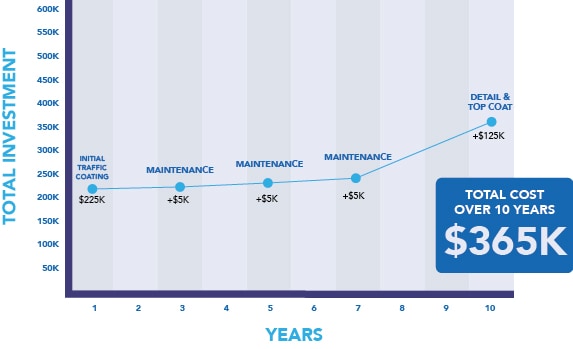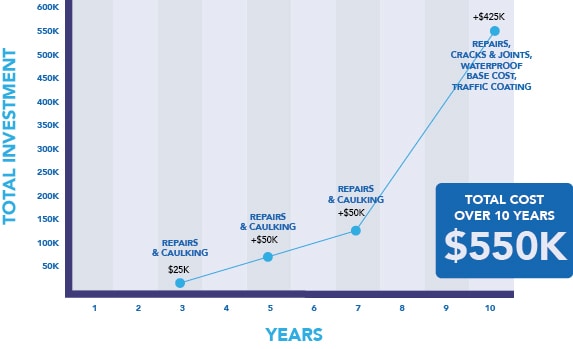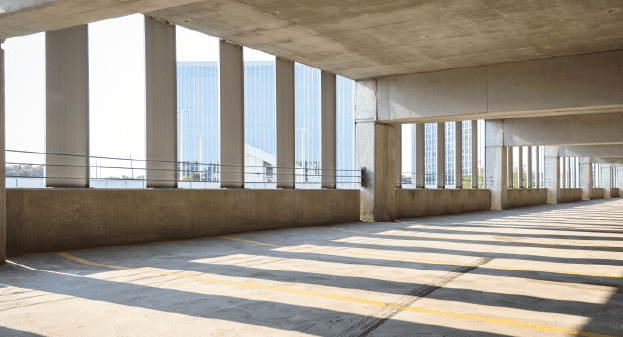By Travis Dunn, Waterproofing and Coatings Division President
Maintaining a commercial property, especially one that has a parking garage on the premise, can be costly. A visitor’s overall perception of a business can be influenced by this first touch point: parking. Providing a welcoming experience for your property’s guests through their parking needs supports the motivation to maintain your parking amenities. If the experience is poor, it can cause frustration and result in a negative correlation with your business.
Proper and routine maintenance will help extend the life of the structure, preventing deterioration, which increases the cost of necessary repairs, and safety hazards. With a good preventative maintenance program, a parking garage can be expected to last much longer than the estimated 30–40 year life expectancy, which is the average life span of a steel reinforced concrete structure with deferred maintenance. It is recommended to budget $150 to $500 per parking space per year for the operating and maintenance expenses of a parking garage. It is critical to be educated on the common signs of a deteriorating parking garage with the purpose of properly budgeting for maintenance and repairs.
Indicators that a parking structure needs repair, or a waterproofing coating are:
- Water leaking or ponding water
- Expansion joint failure
- Rust stains on the concrete from structural steel corrosion
- Efflorescence, mineral deposits, and water staining
- Cracking, delamination, or spalling concrete
- Exposed rebar
- Peeling, worn, or failing existing coating
Parking structures are subject to weather, vehicular traffic, heavy loads, elements and conditional exposures, such as: rain, snow, ice, de-icing chemicals, sand, thermal expansion and contraction, dynamic vehicle loads, flexural stress, and more. These elements and conditions cause cracking, failures, and in general will accelerate the deterioration and reduce the useful life of your garage. If left without proper maintenance your garage is not only an eye sore, but it can lead to safety hazards.
With cracking in parking garages, property owners often weigh two different approaches for maintaining or repairing the structure. One solution is to caulk joints and cracks combined with isolated repairs, and the second approach is to install a full waterproof traffic coating. Caulking and isolated repairs are a cost-effective approach for treating visible areas. However, it will not address the root cause of the problem – water penetrating the concrete. Typically, repairing and caulking the concrete can extend the life of a parking structure for a very limited time, depending on the severity of the cracks, but it does not stop water penetration. Alternatively, with a more comprehensive approach, applying a waterproof traffic coating prevents moisture from seeping into the concrete, mitigating additional damage within the structure, and extending the useful life of the parking structure.
To better understand the cost implications, let us take a 50,000 sq. ft. parking structure with a waterproof traffic coating versus figure 2 of a garage with deferred maintenance over 10 years. The total 10-year cost to maintain a 50,000 sq. ft. parking structure could be approximately $360,000. See figure 1 for reference.
Figure 1

If the 50,000 sq. ft. parking structure is not regularly maintained with a waterproof traffic coating and the maintenance is deferred for 10-years, or if only caulking and isolated patching are performed within the 10-year period, the structure will need additional significant and costly repairs. Without a waterproof traffic coating, water continues to seep into the concrete – corroding the steel and causing structural damage. Deferring maintenance could increase the overall cost to maintain the structure to approximately $535,000 or more. See figure 2 for reference.
Figure 2




